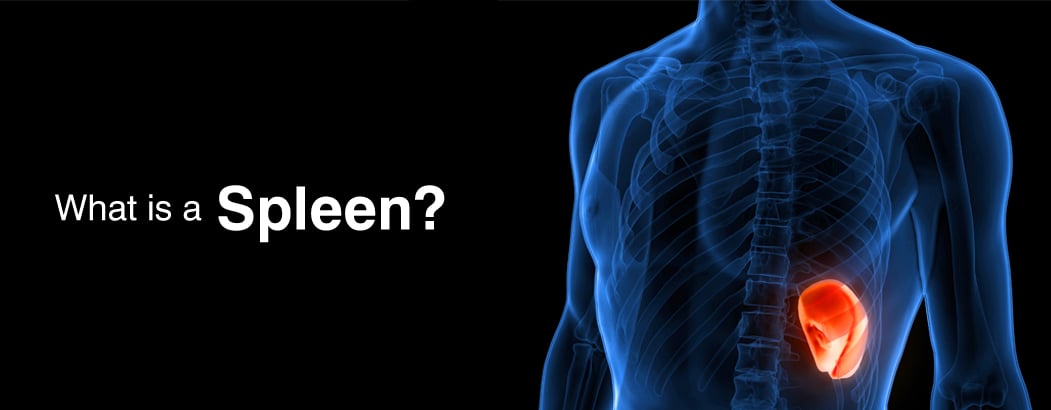What is a Spleen?
September 1, 2023

Introduction
The spleen plays a vital role in the body. It is located above the stomach on the side of the abdomen. This small organ is a part of the overall system. Carries out several important functions. It stores blood, produces blood cells and antibodies, and aids in the maintenance of proper fluid levels in the body. In this article, we will look at the structure, functions, causes, diagnosis, and treatment of spleen problems.
Table of Contents
-
- Introduction
- What is a Spleen?
- Anatomy of the Spleen
- Functions of the Spleen
- What causes Spleen Pain?
- Diagnosis and Treatment of Spleen Problems
- Conclusion
- Frequently Asked Questions
- Where is the Spleen located?
- What Happens When Spleen is Enlarged?
- How Long Can You Live Without a Spleen?
- Where is Spleen Pain pain felt?
What is a Spleen?
The spleen is an essential component situated in the uppermost section of the abdomen, situated below the ribcage. Despite being a relatively small body organ, it serves a variety of crucial functions in the human body.
The primary task of the spleen is to filter blood, serving as a reservoir that aids in expelling broken red blood cells and platelets from circulatory channels. It is also required for the immune system, as it stimulates the production of white blood cells and antibodies for defense against health problems.
The spleen acts as a reservoir for red blood cells, releasing them into the circulatory system during hemorrhage.
While the spleen is beneficial, it is not a crucial organ, as individuals can survive without it if needed. Nonetheless, its removal can increase the odds of infections and necessitate additional preventive measures to sustain overall well being.
Anatomy of the Spleen
The spleen, an organ found in the upper left part of the abdomen beneath the ribcage, has several important aspects to consider when studying its anatomy:
- Location: The spleen is positioned below the ribcage, on the side of the diaphragm. Typically, it rests between the 11th and 12th ribs. However, slight variations in its location can occur from person to person.
- Size and Shape: Normally, the spleen is about the size of a fist or a small flattened football. It has an elongated shape with a curved surface and a concave lower surface.
- Capsule: Enclosed within a capsule made of connective tissue, the spleen is protected and maintains its shape due to this covering.
- Blood Supply: Being highly vascularized, which means it has a blood supply, blood flows into the spleen through the artery and exits through the splenic vein.
- Structure: Internally, two main types of tissue can be identified within the spleen:
- White Pulp: This region contains lymphocytes—a type of blood cell. Plays a crucial role in immune responses. It forms nodules around arteries.
- Red Pulp: The red pulp of the spleen is a section that contains a network of sinuses filled with blood. Its main role is to filter and eliminate damaged blood cells as well as platelets.
The spleen performs functions such as blood filtration, immune system support, blood storage, and iron recycling. Understanding the anatomy of the spleen is essential for understanding its role in maintaining health and its significance in bodily functions.
Functions of the Spleen
Despite being overlooked, the spleen proves to be an organ with multiple roles that significantly contribute to overall health. In this article, we will explore its functions. Shed light on how this unassuming organ plays a vital part in the body’s intricate systems.
1. Blood Filtration
One of its core responsibilities is filtering the blood. Acting as a guardian, the spleen carefully examines each blood cell that passes through it. It. Eliminates worn-out or damaged blood cells and platelets to keep the bloodstream free from cellular debris.
2. Immune System Hub
The spleen serves as a hub for system activity. Within its confines, it houses types of blood cells, particularly lymphocytes, which play a crucial role in producing antibodies.
The spleen’s incredible immune abilities help protect the body against infections, making it an important ally in the fight against pathogens. Additionally, the spleen also acts as a storage facility for blood cells and platelets, not just filtration. During times of bleeding or low oxygen levels, it can release these stored cells into circulation to support the body’s resources.
Iron Recycling
Another crucial function of the spleen is its ability to recycle iron from blood cells efficiently. This recycled iron is then used to produce blood cells, contributing to the overall balance of iron in the body.
The spleen plays a role beyond its size by maintaining blood quality, supporting the system, and ensuring critical components are available when needed. Understanding these functions offers insights into how important the spleen’s functions are for our overall health and well-being.
Spleen pain is not very common. Can be quite uncomfortable with potential causes. It is essential to understand these factors that contribute to spleen pain for diagnosis and effective management.
What causes spleen pain?
1. Enlarged Spleen (Splenomegaly)
- Infections: Conditions such as mononucleosis, bacterial infections, or parasitic infections can result in a spleen and subsequent pain.
- Blood Disorders: Problems related to blood, like leukemia, lymphoma, or certain types of anemia, may cause the spleen to enlarge and become painful.
- Liver Disease: Liver conditions like cirrhosis can lead to increased blood pressure in the veins connected to the spleen, causing them to enlarge and cause discomfort.
2. Trauma and Injury
Physical Trauma: Any injury or trauma sustained on the side of the abdomen, such as a fall or accident, can lead to pain in the spleen. Severe impact can even rupture the spleen, requiring attention.
3. Inflammatory Conditions
- Infections: Viral or bacterial infections like mononucleosis, malaria, or endocarditis can cause inflammation and pain in the spleen.
- Autoimmune Diseases: Conditions such as lupus erythematosus (SLE) or sarcoidosis can result in inflammation and discomfort in the spleen.
4. Blood Flow Issues
Splenic Infarction: Reduced blood flow to the spleen due to conditions like clot formation can cause tissue damage. Resulting in pain.
5. Cysts and Abscesses
Occasionally, there may be the development of cysts or abscesses in the spleen, leading to pain.
It’s important to note that the spleen itself does not have pain receptors, so discomfort often arises from the surrounding structures. If you are experiencing pain in your upper left abdomen, it is crucial to seek medical attention. Accurate diagnosis and timely intervention are factors in managing issues related to the spleen and ensuring your well-being.
Diagnosis and Treatment of Spleen Problems
Spleen problems can range from discomfort to medical emergencies. Timely diagnosis and appropriate treatment are crucial for managing these issues. In this guide, we will outline the steps involved in diagnosing spleen problems. Discuss the available treatment options.
1. Diagnosis
Medical History and Physical Examination: The diagnostic process usually starts with a review of your history to identify potential risk factors or symptoms associated with spleen problems. A physical examination, including touching and examining your abdomen, helps assess the size of your spleen as well as any tenderness.
2. Imaging Tests
- Ultrasound: This non-invasive imaging technique can provide information about the size, shape, and any abnormalities of your spleen.
- CT Scan: A computed tomography (CT) scan generates sectional images that aid in diagnosing conditions affecting the spleen.
3. Blood Tests
- A complete blood count (CBC) is performed to evaluate the health of the blood, including assessing white blood cell counts, which spleen problems can influence.
- A blood smear test involves examining a blood sample under a microscope to identify any abnormalities in the shape and size of blood cells.
- Liver function tests are conducted to assess liver health since liver and spleen conditions can often be interconnected.
4. Biopsy
In some cases, a small tissue sample (biopsy) of the spleen may be taken for laboratory analysis. This is typically done using a procedure known as fine needle aspiration.
Treatment
The choice of treatment for spleen issues depends on the condition and its severity. Here are common approaches to treatment:
1. Monitoring
For spleen enlargement or minor injuries, a “wait and see” approach may be adopted. Regular monitoring through imaging techniques and blood tests can help track progress.
2. Medications
If an infection is identified as the cause, antibiotics may be prescribed to treat the infection and reduce inflammation in the spleen.
Pain relievers, whether over the counter or prescription, may also be recommended for managing pain.
3. Surgery
In cases such as a ruptured spleen or specific medical conditions, doctors may recommend removal of the spleen (splenectomy). However, it’s important to note that this procedure carries risks, including an increased susceptibility to infections.
4. Lifestyle Changes
To decrease the risk of injury or infection after a splenectomy, healthcare professionals may advise making lifestyle modifications such as avoiding contact sports.
5. Treating Underlying Conditions
If spleen problems are caused by a condition like leukemia or liver disease, it is crucial to prioritize treating that condition.
Remember to consult with a healthcare provider for a diagnosis and a personalized treatment plan tailored to your situation. Early intervention and careful management can enable individuals with spleen problems to lead their lives while addressing their medical needs.
Frequently Asked Questions
1. Where is the Spleen located?
The spleen is situated below the ribcage on the side of the abdomen, close to the stomach.
2. What Happens When the Spleen Enlarges?
When the spleen enlarges, it can cause pain in the abdomen and compromise its blood-filtering function. This can potentially lead to decreased levels of blood cells and an elevated risk of infection. It’s worth noting that underlying health conditions often contribute to spleen enlargement and necessitate treatment.
3. How long can a person survive without a spleen?
While it is possible to live without a spleen, the absence of this organ raises the likelihood of infection. However, with attention and vaccination, most individuals can maintain normal lifestyles even after undergoing a splenectomy. Where does one typically experience pain associated with the spleen? Pain related to the spleen is usually felt in the part of the abdomen located just below the ribcage on the left side of your body.








